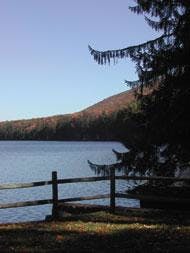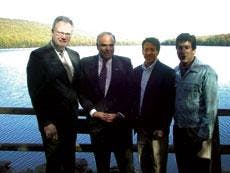Utility, Conservation Fund Partner To Preserve Environment
By Larry Selzer
Pennsylvania Suburban Water Company (PSW), the largest subsidiary of Philadelphia Suburban Corp., and The Conservation Fund recently partnered to help preserve the environment by using a real estate technique called splitting resource rights.
It is common for investor-owned companies to believe that protecting the environment will always cost money. However, in a unique partnership that proves this to be a misconception, PSW and The Conservation Fund recently completed a land sale of 7,000 acres that surrounds and buffers PSW's water reservoirs in central Pennsylvania. The goal was to permanently protect the land from development or any other commercial or residential use. As part of the agreement, PSW donated 2,000 acres in addition to the 7,000 acres originally sold, while retaining ownership of its water reservoirs.
The property, owned by PSW since the late-1800s, stretches over 10 miles along a valley – known as Brush Valley – and contains several water reservoirs, the largest of which is 266 acres. It also contains a large swath of uninterrupted woodlands.
As a water utility responsible for providing quality water to its 2.5 million customers, PSW had a vested interest in maintaining reservoir ownership. This allowed PSW to ensure continuance of watershed protection and the quality of its raw water supply.
PSW also has a responsibility to its investors to provide a return on their investment and improve shareholder value. Both of these responsibilities have benefited from this agreement, which has resulted in an increased amount of cash on the bottom line and a decreased amount of debt.
In this win-win situation, The Conservation Fund agreed to purchase the land surrounding the water reservoirs, allowing both PSW and The Conservation Fund to protect the land, environment and watershed for future generations from contamination caused from potential land development.
In order to achieve this, The Conservation Fund teamed with Richard King Mellon Foundation to finance half of the project's $4.4 million cost, while the Pennsylvania Department of Conservation and Natural Resources' (DCNR) Community Conservation Partnerships Program provided the remaining capital.
The Conservation Fund has since transferred the acquired land to the State of Pennsylvania with the help of DCNR. The land was integrated into the state's forest system as part of the 43,000 acre Wyoming State Forest, which is located primarily in central Pennsylvania. The forest offers public recreation opportunities, such as hunting, fishing, hiking, horseback riding, mountain biking and wildlife watching.
"These precious lands will be forever protected by the Commonwealth for the enjoyment of all Pennsylvanians," said Nicholas DeBenedictis, PSW chairperson and CEO. "We are pleased to continue to ensure protection of the valuable water resources contained within these woodlands, and that the reservoirs will continue to serve as a water supply for the residents of the Roaring Creek Watershed."
For companies wanting to increase their return on assets and bring cash to the bottom line, splitting resource rights is an ideal solution. The technique enables public and private entities to form partnerships that share risk and economic and environmental rewards. Splitting the landscape's resource rights allows companies to continue to own those assets central to their business activity while generating cash from those assets that are not.
The Conservation Fund has worked with leaders in a wide range of industries – electric utilities, water utilities and forest products – to structure agreements that use this splitting resource rights structure. By following PSW's example, public water utilities across the country may be able to monetize real estate assets, protect their water resources and preserve the environment.
In August of 2002, The Conservation Fund created a similar arrangement in Tennessee on the Cumberland Plateau, near Nashville, that separated the land and the development rights of timber on a 75,000-acre property sold by International Paper. Under a creative shared-use agreement between the state and Renewable Resources Inc., the timber buyer, the land will remain a working forest available for public use and outdoor recreation.
The Conservation Fund worked with Renewable Resources to develop a plan to ensure that the working lands will be managed as a sustainable forest and to maintain hardwood forest cover. Forestry operations currently meet or exceed all requirements of both the Sustainable Forestry Initiative® (SFISM) program and the Tennessee Best Management Practices for forestlands to ensure protection of critical habitat. The land was then transferred to the state of Tennessee in February 2003 and incorporated into a larger wildlife territory called Sudquist Wildlife Management Area.
Conclusion
The Conservation Fund believes that the splitting resource rights technique is an emerging trend that will gain popularity as more companies realize its effectiveness, particularly in the water utility industry. Benefits include permanent protection of water resources used by the company, cash benefits from the land sale and elimination of property taxes, insurance and maintenance costs associated with the property. Meanwhile, the company's operational structure remains the same and the company is able to continue to provide unhindered service to its customers.
About the author: Lawrence A. Selzer is President and Chief Executive Officer for The Conservation Fund, a national nonprofit organization headquartered in metropolitan Washington, D.C. Before being named President in December 2001, Selzer served as Senior Vice President of Sustainable Programs for the organization.


